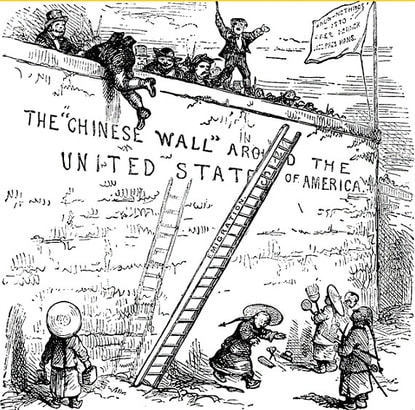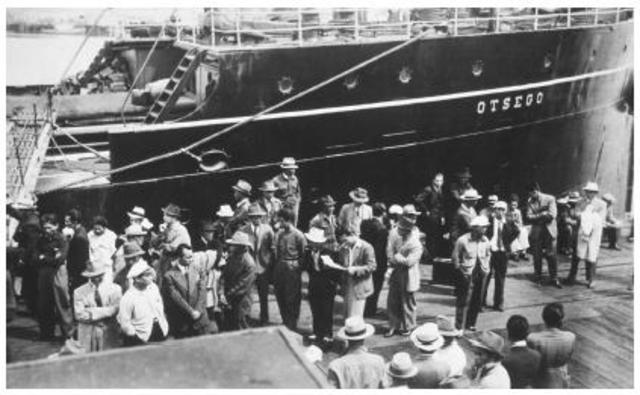
Trump and his true believers believe immigrants harm the U.S. Trumpers deny any evidence presented by economists and other experts that show immigration has a positive effect on the U.S. Specifically, Trump loyalists think immigrants lower the salaries of native workers and displace them from their jobs; increase the tax burden of public services and assistance; pose a threat to public health; and overwhelm the ability of the U.S. absorb so many “strangers.” They want to drastically reduce the absolute number of legal immigrants and refugees admitted to this country, eliminate family-based immigrants, and increase educational requirements for immigrants. And they want to build a wall, strengthen security measures, and stop undocumented immigrants from entering the country.
While anti-immigrant sentiments are present in many countries, it is less understandable in the U.S. The popular creed of the U.S. is that immigration is the foundation on which the country was built. Trump and his true believers acknowledge that the contributions of former immigrants, but believe that current immigrants take more from the U.S. and its citizens than they contribute. What caused this extreme reaction against immigration at this time? Have the conditions in the U.S. changed and is immigration thus more costly to the nation? Or, are the immigrants who are arriving in the U.S. different now than earlier?
History of Immigration in the United States
Despite Congress’s power to set naturalization criteria, immigration policy, generally, was left to the states. It would take some time for antipathy felt by the native-born toward immigrants to guide federal immigration policy. Early federal laws were primarily concerned with ensuring that immigrants were healthy and able to support themselves. Until the mid-1800s most of the immigrants admitted on the East Coast were Irish or German. Anti-immigrant nativists viewed these immigrants with hostility and formed a political party, the “Know-Nothings” to combat immigrants. Hostility to these new arrivals was assuaged as many of these immigrants participated in the Civil War.
Most of these Chinese were males coming to earn money so that they could return to China with enough money to live well. These immigrants worked in mines and helped to build the Union Pacific railroad. Initially, Chinese immigrants were welcomed because they did the hard and dangerous work native workers were reluctant to do. But as the number of Chinese immigrants grew the native antipathy to them also increased. The California legislature taxed immigrant mine workers, and the U.S. Congress passed the Page Act of 1875 to prevent the immigration of Chinese women. In 1882 the U.S. Congress passed the Chinese Exclusion Act. The Act banned all Chinese immigration. Passage of this Act preceded riots and violence against Chinese residents. To meet the labor shortage created by the Chinese Exclusion Act, immigrants from Korea, Japan, and Asian countries were recruited for farm labor. In 1877 the Alien Land Act prohibited Asian immigrants from buying land because they could not become naturalized citizens.
The Immigration Act of 1891 was passed to give the federal government control over the admission and naturalization to these immigrants. As a result of the Spanish American War of 1898, the Philippines became a colony of the U.S., and many Filipinos came to the U.S. as farmworkers. When the Philippines became a commonwealth, Filipino immigration was barred under the Oriental Exclusion Act. By 1913 Asian farmworkers supplied enough farm labor to pose a threat to native farmers.
Although anti-immigrant feeling somewhat dissipated following WWI, anarchist violence and labor strikes stoked a red scare directed primarily Jews and Russians. In part, as a result of this violence and strikes, a quota system was established. It limited new immigration from individual nations to not exceed more than two percent of the immigrants from that nation living in the U.S. in 1890, before a significant migration of Southern and Eastern Europeans. As the number of Jewish refugees increased due to Hitler’s rise in Germany, humanitarians argued for the admission of Jewish refugees exceeding the 2 percent quota imposed by this law. Nativists opposed to the entry of Jewish refugees prevented their entrance.
This Mexican influx led to a number of retaliatory acts against Mexican-Americans and Mexican immigrants. Patients were removed from hospitals and taken to the border. Public employees were arrested and deported. Latino neighborhoods were raided, and the people found there also expelled. Many of these people were American citizens.
During World War II, the loss of native labor once again renewed the demand for Mexican labor. In 1943 temporary Mexican laborers were admitted to the U.S. under the bracero program to fill agricultural jobs. Undocumented Mexican workers also migrated to the U.S. to work, and some braceros overstayed their temporary permits. Farmers were glad to hire these Mexicans because these undocumented workers could not organize or ask for higher pay. After the war, many nativists resented the program because it lowered wages and brought foreigners to the country. These nativists also protested about crimes that these foreign workers supposedly committed.
In 1954 President Dwight Eisenhower, concerned about illegal immigration, implemented Operation Wetback. Operation Wetback was a program to deport undocumented Mexicans. The Border Patrol, U.S. military, and other law enforcement agencies packed any undocumented workers they found into buses and trains and shipped them into the interior of Mexico so they could not quickly return to the U.S. Eighty-eight workers who had been transported to the Mexican dessert died of heat stroke. One aspect of this program was to strike fear into workers to deter them from returning to the U.S.
Despite practices in the program that allowed workers to be abused, the bracero program continued until 1964 because it provided cheap labor to farmers. Undocumented immigrants continued to come to the U.S. for employment and were welcomed by employers as a source of cheap and pliant labor. Thus, the seeds were sown for cheap labor from Latin America. Political upheaval and the anti-Communist fight in Latin America, especially Cuba, also increased the flow of immigrants.
 ULISES RODRIGUEZ / REUTERS
ULISES RODRIGUEZ / REUTERS Trump and his followers cling to the harmful myths and fear-inducing anecdotes. They mainly focus on low skill workers and undocumented immigrants to support their beliefs. While it may seem reasonable to assume that as low skill immigrants move into an area, the salaries of American workers will be lowered. But like many other seemingly reasonable beliefs about immigration, economists have proven these assumptions wrong. In truth, low skilled immigrants are most likely to displace prior immigrants—those most like themselves—rather than native workers.
The focus on undocumented and low skill immigrants allows Trump to claim that they are more likely to be drug traffickers and violent criminals like MS-13. In fact, studies have found that the presence of immigrants is either not associated with increased crime rates or is related to a decrease in crime. According to the U.S. Border Patrol, of the annual influx of the 45,400 undocumented and unaccompanied minors entering the U.S., about 56 are suspected or confirmed as MS-13 gang members. In contrast, there are about ten thousand MS-13 gang members in the U.S. spread across 40 states. There is no evidence supporting the claim that undocumented or low skill immigrants increase U.S. crime.

However, U.S. Citizenship and Immigration Service’s primary consideration in granting legal immigration status is the applicant’s ability to be financially independent of public assistance. Immigrants who receive legal status as part of the family reunification program (what Trump demeaningly calls “chain migration”) must be sponsored by family members who can assure financial independence. Immigrants who are not sponsored by family members must wait at least five years before they are eligible to receive benefits. The only exceptions to the general prohibition on immigrants receiving aid are made for minor children, refugees, and asylum seekers. Undocumented immigrants are generally ineligible for any assistance, although they are subject to some taxation, such as sales taxes.
In part, because immigrants face stringent eligibility requirements for public assistance they use less than the native-born. Moreover, when immigrants receive benefits, the value of the benefits they receive is usually less than that obtained by the native-born. The combination of less use and lower benefits means the overall cost of public benefits is substantially less for immigrants than for comparable native-born adults and children.
Undocumented immigrants pay an estimated $11.2 billion dollars in state and local taxes. Besides state and local taxes, the bulk of which is made up of sales and property taxes, undocumented immigrants are estimated to have paid $23.6 billion dollars in federal income taxes. About half of all undocumented immigrants pay taxes in the hope that their tax records will, at some point, be used to show how long they have been in the U.S. and to help them obtain legal status. Also, low-skilled immigrants, including the undocumented, help lower the prices paid by consumers for services in large cities with immigrant populations.
Furthermore, immigrants will be needed to make for the loss to the labor market of retiring baby boomers. Immigrants, including undocumented immigrants, are already contributing to the Social Security and Medicare of native workers and will be needed to provide more in the future. According to the Social Security Administration, undocumented workers contributed $13 billion dollars to Social Security, although most will never benefit from their contributions.

While tuberculosis can be transmitted between immigrants who are living or traveling in close contact with each other, this disease is rarely spread by casual contact. The number of tuberculosis cases in the U.S. was about 9500 hundred in 2013 and is declining over time. HIV/AIDS is spread through sexual activity or needle sharing and poses little risk of transmission to U.S. citizens higher than that of transmission between U.S. citizens. The risk posed by Ebola has not been concentrated among immigrants. The only U.S. residents who have contracted Ebola in the continental U.S. were two nurses in 2014.
Other communicable diseases, such as mumps, measles, and whooping cough are vaccine-preventable and present no threat of an epidemic to the U.S. People living in some Latin American countries have vaccination rates comparable or better than people living in the U.S.
None of these concerns about communicable diseases apply to refugees because they are screened before entry to the U.S. Similarly, documented immigrants to the U.S. are also screened for communicable diseases like active tuberculosis. Most diseases imported to the U.S. are by either U.S. citizens returning from trips abroad or from foreign tourists or temporary workers.
Although the immigrant share of the population has been higher than it is now, immigrants were assimilated. The people who say they are concerned about immigrants’ assimilation to seem to be more concerned about the negative feelings native citizens feel in the presence of immigrants.
Trump and his true believers expect the merit approach to restricting immigration to workers who will help the economy grow. In addition, Trump and his true believers also seem to assume that merit immigration would reduce the number of immigrants from countries they deem less desirable. Based on the outcomes Canada has experienced from merit-based immigration system, it is unlikely to fulfill Trump’s expectations.
The Canadian merit-based immigration systems select candidates on the basis of their skills, education, adaptability, and family ties or networks. While these qualities permit immigrants to fill labor market needs, they are also highly subjective. Between 2006 and 2015 less than 50 percent of the candidates for immigration were selected for only their economic prospects. The remainder of the immigrants were spouses, partners, children, parents, grandparents, and refugees.
Besides ensuring that high skill immigrants were selected, the Canadian system has not produced the desired economic effects. Immigrant wages and employment, for example, tend to be lower than one would expect based on skill level. Part of the reason for the economic under performance of the system seems to be the failure to adequately take into account different payoffs for educational attainments in various industries. A bachelor’s degree may not yield the same benefits in physics as in business. Moreover, immigrants’ foreign qualifications may not be recognized by Canadian employers. One immigrant engineer reported that he had designed trains for Siemens in India, but had to obtain another degree in engineering from a Canadian school for an entry-level job at Siemens Canada.
The Canadian merit-based system has not advantaged the number of immigrants from the U.S. and Europe. Between 2011 and 2016 there were more than twice as many immigrants from Central America and the Caribbean than from the U.S. and more immigrants from Africa than from Europe and the U.S. combined. Immigrants from these regions of the world are typically highly skilled, even though they may not be able to obtain jobs that are commensurate with their education. Thus, an unanticipated consequence of a merit-based system is that provides workers who compete with lower skilled native workers.
Limiting immigration to high skill workers is, in part, to pay deference to the value in entrepreneurship and innovation that immigration has brought to this country. This approach to immigration also addresses the mythical problems that are raised as reasons for wanting to limit immigration. Somehow these high skilled workers are expected to avoid the hostility that afflicts low skill workers. Favoring high skilled immigrants, like the merit approach used by Canada, can also create problems that lead to resentment. Welcoming diversity seems to be the only approach that consistently works.
Most importantly, although there may always be different opinions about how to address immigration, agreement is currently impossible because the US President and his followers are basing all of their positions on lies.



